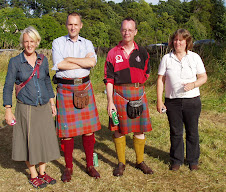I think we edged somewhat forward yesterday. My husband is willing to admit only that we held our ground. In any event, I feel a bit better.
London: we had four good days of looking at art. The highlights were the big show of pictures on loan from Russia at the Royal Academy, and Anthony McCall, who sculpts in light, at the Serpentine. Wonderful!
The remaining day, Sunday, was a welcome respite from art. Our son James, in Beijing, has become interested in family history and collects ancestors the way I collect Vogue Knitting Books. He had got wind of a family tomb in Brompton Cemetery, and had sent us instructions from the cemetery authorities about how to find it. Thomas-the-Elder kindly drove us there on Sunday afternoon.
It was a lovely afternoon, and a pleasant place, a Royal Park. (But for interesting dead people, you do better at Kensal Green.) We found our tomb with no difficulty, perfectly legible, not overgrown with ivy. This is a picture of my husband transcribing the inscriptions.
London: we had four good days of looking at art. The highlights were the big show of pictures on loan from Russia at the Royal Academy, and Anthony McCall, who sculpts in light, at the Serpentine. Wonderful!
The remaining day, Sunday, was a welcome respite from art. Our son James, in Beijing, has become interested in family history and collects ancestors the way I collect Vogue Knitting Books. He had got wind of a family tomb in Brompton Cemetery, and had sent us instructions from the cemetery authorities about how to find it. Thomas-the-Elder kindly drove us there on Sunday afternoon.
It was a lovely afternoon, and a pleasant place, a Royal Park. (But for interesting dead people, you do better at Kensal Green.) We found our tomb with no difficulty, perfectly legible, not overgrown with ivy. This is a picture of my husband transcribing the inscriptions.

His great-grandfather is buried there, and Great Aunt Henrietta whom he can just remember.
Knitting
The gansey progresses well. And I remember I have promised a pic of the KF socks.
“Boho Baby Knits” has arrived and is full of good things. It is sort of sad when you find yourself so far advanced in life that your grandchildren are, largely, past wearing such garments.
But not quite all of them. I am re-enthused about the Poet’s Coat. It is shaped in the front – I hadn’t realized that – and straight across the back. If this (discovered in an image-search) is really a swallowtail coat, the Poet’s Coat could easily be adapted to suit by the addition of a modest tail in the back.
But the Oxford English Dictionary is emphatic that “swallowtail” implies a forked tail, like a swallow. I need to struggle on with image-searching.




Hello Jean,
ReplyDeleteThe image you found at the front looks very like a swallowtail, in my opinion. A curved front and an overlapping flap at the back, should be reasonably easy to come up with, no?
For politics, you will probably enjoy today's post by Carol from Go Knit in Your Hat.
I always had the impression that a swallowtail coat was the Regency-style evening dress - straight across at the waist in the front and two long tapering tails to about knee length at the back. You could try contacting the Museum of Costume in Bath http://www.fashionmuseum.co.uk/
ReplyDeletefor further information.
Karen
A swallowtail coat is the same as a claw-hammer jacket, which may not be very helpful. Here is a picture of John Ruskin's court dress, which includes a swallowtail coat http://tinyurl.com/3dba8u I'm pretty sure any tailcoat is a swallowtail, but I will check that.
ReplyDeleteThink of what a butler wears. Jeremy Fisher had a tailcoat, although he didn't wear it when he was out fishing, when he wore a short raincoat. He wore a red tailcoat at home. The cut of a swallowtail has varied over the last couple of centuries, and still varies according to whether it is being worn in the morning or the evening, so you can largely do what you like as long as it has split tails at the back.
Hi Jean: so glad you got to see the Russian art -- I'd love to see it again. When you live "there" you see these masterpieces many times, and "almost" take them for granted. Strangely enough, my favorite museum was always the Russian Museum in St. Petersburg, and not the Hermitage (which REALLY needs a makeover).
ReplyDeleteThere has to be ONE person in every family who does the genealogy thing and in the end you are grateful for it. I have mixed feelings about "being buried" but have a fascination from the social anthropology view about cemeteries - the old ones really give you a glimpse of the "times". Go figure.
Keep us posted with your Swallowtail findings!
Have to laugh about your grandchildren: I made more than 10 "knit from the neck down" pullovers for my children and nieces and nephews, and now a big Teddy Bear wears my daughter's one from when she was two. But where did I get the pattern from? EZ, probably, but ...? MaryjoO
Hi Jean,
ReplyDeleteI think a Swallowtail Jacket is much like a Day Coat with the tails cut a bit more extreme.
Obama comes here Saturday and my son, who will vote for the first time, is thrilled about it.
I have a number of books on 18th and 19th century garment construction at home - I'll have a look this weekend if you like.
ReplyDeleteBut my impression is that the linked picture is a frock coat of some kind, that the swallow tail has to be cut back more substantially - like a modern gentleman's white tie formal jacket.
Here's my 2 cents on the Swallow Tail coat, coming from my costume background.
ReplyDeleteThirty years ago, where I worked, it was called a Morning Coat. Worn by Englishmen at Ascot.
It is not cut straight at the front, but rather swoops from the waist button to the center back in an arc. The back tail should end around the wearer's knees.
Anyway, whether you want a tail coat or a "swallow tail," neither is hard for a woman of your talents!
Jean, if you look for a Victorian Cutaway Coat, also known as a Morning or Swallowtail Coat, I think you'll have more success. There's some pictured at
ReplyDeletehttp://www.gentlemansemporium.com/store/coats.php
They're almost at the bottom of the page and clicking on "closer look" will let you see the front and back views so you can get a good look at how the swallowtail look is actually formed.
Hope that helps some and most of us Barack supporters are feeling very happy right now though we're hearing rumblings about a possible team ticket of Barack/Clinton by Convention time. Who would have the top bill there is anyone's guess.
As I understand it, frock coats were straight down in the front with the usual right angle corners, not curved like the Poet Coat. But the word "frock" has changed greatly over time and has had conflicting meanings at the same time and place - a girl's dress, a man's overcoat, a woven wool workman's smock, and a knitted gansey possibly worn as underwear, all called "frock" in the early 19th century.
ReplyDelete